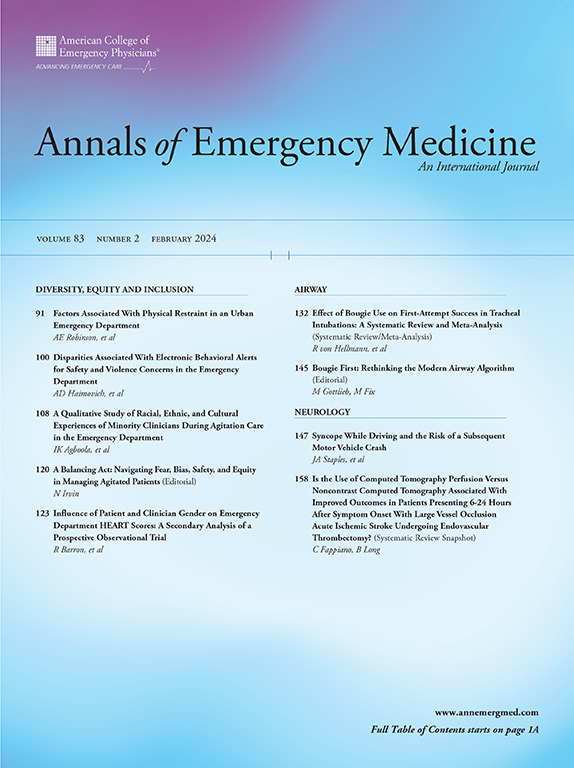Treatment of Opioid Use Disorder Across a National Emergency Department Practice Improvement Network.
IF 5
1区 医学
Q1 EMERGENCY MEDICINE
引用次数: 0
Abstract
STUDY OBJECTIVE This study aimed to assess practices surrounding opioid use disorder (OUD), specifically provision of naloxone and medication for OUD (MOUD), in a large sample of emergency departments (EDs) participating in a quality improvement initiative. METHODS Data were obtained from EDs participating in the American College of Emergency Physicians' Emergency Quality Network substance use disorder program, a national practice-based quality improvement initiative. ED sites abstracted data elements from a random sample of discharged visits with diagnosis codes for opioid overdose or OUD. Data were reported in May and October 2023 for visits that occurred up to 6 months prior to the reporting period. The percentages of visits for which naloxone was prescribed or dispensed and MOUD was administered or prescribed were determined. RESULTS There were 6,749 included visits for overdose or OUD reported from 300 unique EDs. Naloxone was either dispensed or prescribed in 1,874 (27.8%) of visits. There were 752 visits (11.1%) in which it was reported that the patient was already taking MOUD. Excluding those visits, MOUD was either administered in the ED or prescribed at discharge 438 times, representing 7.3% of potentially eligible visits. CONCLUSION In this large sample of visits for OUD and overdose, just over a quarter of patients with visits related to opioids were prescribed or dispensed naloxone, and administration or prescription of MOUD to patients not already on it was also low. These findings indicate opportunity for improvement in ED OUD care.阿片类药物使用障碍的治疗跨越国家急诊科实践改进网络。
研究目的:本研究旨在评估在参与质量改进倡议的急诊部门(ed)的大样本中围绕阿片类药物使用障碍(OUD)的实践,特别是纳洛酮和OUD (mod)药物的提供。方法数据来自参加美国急诊医师学会急诊质量网络物质使用障碍项目的急诊科,该项目是一项基于国家实践的质量改进倡议。ED站点从具有阿片类药物过量或OUD诊断代码的随机出院访问样本中提取数据元素。2023年5月和10月报告了报告期前6个月的访问数据。确定纳洛酮处方或配发以及服用或处方mod的访问百分比。结果300个特殊急诊科报告了6749例用药过量或OUD就诊。在1874次(27.8%)就诊中配发或开处方纳洛酮。有752次就诊(11.1%)报告患者已在服用mod。排除这些就诊,mod在急诊科或出院时使用的次数为438次,占潜在合格就诊次数的7.3%。结论:在因OUD和用药过量就诊的大样本中,与阿片类药物相关的就诊患者中,只有四分之一以上的患者处方或配发了纳洛酮,未服用mod的患者服用或处方mod的比例也很低。这些发现表明ED OUD护理有改善的机会。
本文章由计算机程序翻译,如有差异,请以英文原文为准。
求助全文
约1分钟内获得全文
求助全文
来源期刊

Annals of emergency medicine
医学-急救医学
CiteScore
8.30
自引率
4.80%
发文量
819
审稿时长
20 days
期刊介绍:
Annals of Emergency Medicine, the official journal of the American College of Emergency Physicians, is an international, peer-reviewed journal dedicated to improving the quality of care by publishing the highest quality science for emergency medicine and related medical specialties. Annals publishes original research, clinical reports, opinion, and educational information related to the practice, teaching, and research of emergency medicine. In addition to general emergency medicine topics, Annals regularly publishes articles on out-of-hospital emergency medical services, pediatric emergency medicine, injury and disease prevention, health policy and ethics, disaster management, toxicology, and related topics.
 求助内容:
求助内容: 应助结果提醒方式:
应助结果提醒方式:


